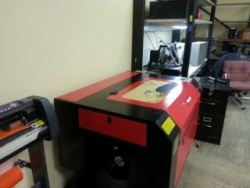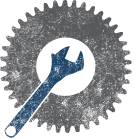From MidsouthMakers - Memphis Area Hackerpace
Location
The big red thing in the common area.
Features
- Red Sail X700
- 60 watt
- Water cooled
- 700mm x 500mm cut area
Safety
- Never let the machine run unattended especially when its cutting!
- Always use approved materials. Some materials can release chlorine gas or catch fire.
- Remember to pull bed leveling knob before running a job.
- Run the machine with the interlock on. The interlock is a key switch that will override the option to turn the laser off when the door is opened.
If a fire Occurs
- Immediately stop the laser, this will more than likely extinguish the fire.
- If fire still exist, try to blow it out.
- If fire still exist, spritz it with the water bottle. Notify the board.
- All else fails, use the fire extinguisher. Notify board.
Testing Plastics for Chlorine
A blow torch and copper wire will be needed for the test.
- With a pair of pliers heat up the end of the copper wire and burn off any residue.
- While still hot, touch a sample piece of the plastic you would like to cut with the hot end of the copper wire.
- Place the wire back into the flame and burn the plastic. If the flame is blue/green the material is not safe and will emit chlorine gas when cut.
Materials
Note: If the material you want to cut isn't listed on this page, email the mailing list.
| Material |
Safe to use with a laser cutter? |
Can you cut it? |
Can you engrave it?
|
| Acrylic |
Safe! |
Yes |
Yes
|
| Wood |
Safe! |
Yes |
Yes
|
| Paper/Cardboard |
Safe! |
Yes |
Difficult
|
| Steel |
Safe! |
No |
Yes (oxidize)
|
| Titanium |
Safe! |
No |
Yields a rainbow of colors depending on power.
|
| All other metals |
Safe! |
No |
Yes, if you use Cermark or other marking chemical.
|
| Glass |
Mostly safe, don't breathe the glass dust. |
No |
Yes
|
| Nylon |
Not recommended. |
Discoloration, low cut quality. |
Melts, doesn't engrave well.
|
| ABS |
Not recommended. |
Discoloration, low cut quality. |
Slight engraving marks.
|
| Polyethylene |
Not recommended. |
No. Lots of melting. |
Slight marks with melting.
|
| Lexan/polycarbonate |
Black smoke and awful smell. DO NOT CUT. |
No |
No
|
| PVC |
Creates Chlorine Gas. DO NOT CUT. |
No |
No
|
| Vinyl |
Toxic fumes. DO NOT CUT. |
No |
No
|
| Teflon/PTFE |
Toxic fumes. DO NOT CUT. |
No |
No
|
| CF/Carbon Fiber |
DO NOT CUT. |
No |
No
|
Feeds and Speeds
Different materials and thicknesses will require different cut speed and power. Table below is a good starting point for some common materials.
Cutting
| Material
|
Power (%)
|
Speed (mm/s)
|
Notes
|
| 5mm Wood
|
55%
|
10mm/s
|
|
| 1/4 Wood
|
95%
|
15mm/s
|
|
| 1/2in Wood
|
75%
|
3mm/s
|
|
| 3/4in Wood
|
|
|
|
| 1/8in Acrylic
|
|
|
|
| 1/4in Acrylic
|
%
|
|
|
| 1/2in Acrylic
|
|
|
|
| EVA Foam (~1/8in)
|
40%
|
75mm/s
|
|
| Poster Board
|
45%
|
150mm/s
|
|
Engraving
| Material
|
Power (%)
|
Speed (mm/s)
|
Notes
|
| Wood
|
23%
|
300mm/s
|
~1mm Depth
|
| Acrylic
|
30%
|
20mm/s
|
3.25mm Depth
|
Maintenance
- Every 8 hours of run time, lenses/mirrors need to be checked/cleaned.
Maintenance Log
- 11/16/2014 Laser Init.
- 11/17/2014 Alignment and lense cleaning
- 12/08/2014 Booster and external ventilation completed.
Consumables
- Mirrors/Lenses. They are replaced when worn/scratched/damaged $160
- Laser Tube. 3,000 HR runtime. $410
Authorized Users



